by Maxine Carter-Lome, publisher
It is said that Kurt Vonnegut used his hardwood floor as his desk. He worked from his lap with everything—papers, notes, drafts—spread out around him. Virginia Woolf often wrote in a low armchair with a plywood board across her knee. Henry David Thoreau wrote Walden on a simple Hepplewhite-style desk made of painted pine.
Whether it’s a table at a local coffee shop, where J.K. Rowling is said to have written Harry Potter, a writer’s shed far from the maddening crowds, a custom-outfitted home office, bar stool, or a lone corner with an inspirational view, writers are as much inspired by their writing tables as they are the writing routines that keep them engaged until the last word gets on the page.
Looking for some inspiration and creativity for your own writing project? Consider what’s worked for these famous writers:
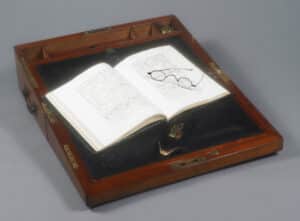
Jane Austin (1775-1817)
In 1794 Jane Austen’s father gave her this portable “writing box.” When open, it provides a slope on which to rest the paper while writing. Its various compartments include a space for an inkpot and a lockable drawer for paper and valuables. Between 1795 and 1799 Austen produced first drafts of what would later become Sense and Sensibility, Pride and Prejudice, and Northanger Abbey, perhaps using this very writing desk. While traveling through Dartford in 1798 she almost lost it—and her savings of seven pounds—when it was accidentally placed in a horse-drawn chaise heading for Dover. When Austen died in 1817, aged 41, the desk was inherited by her sister Cassandra. It was later passed down through her eldest brother’s family. In 1999, Joan Austen-Leigh, Jane Austen’s great-great-great-niece, generously entrusted it to the care of the British Library.
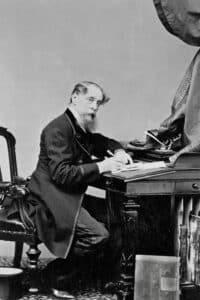
Charles Dickens (1812-1870)
Considered one of the greatest novelists of the Victorian era, Charles Dickens had a very specific routine to his daily schedule, treating writing much like any day job. After waking at 7 a.m., breakfast at 8 a.m., he was in his study working by 9 a.m., not leaving until 2 p.m. when he had lunch with his family. After that, he’d take a vigorous three-hour walk. These walks were integral to Dickens’s success as an author. Not only did they provide him with space to muse on his writing and consider future developments, but they were also key to Dickens’s unrivaled knowledge of the city. The rest of his evening was spent in relaxation and contemplation. With this rigid schedule, Dickens was able to keep up with his constant deadlines and could easily produce 2,000 words a day.
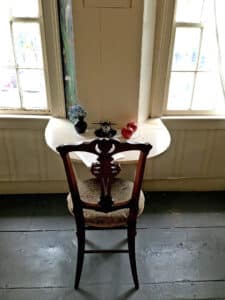
Louisa May Alcott (1832-1888)
Louisa May Alcott is most well known for her classic novel Little Women. She wrote by hand at this writing desk at Orchard House. After years of disappointing reception to her writing, her publisher suggested that she try writing a “girl’s story.” She composed the book that became Little Women in two and a half months, basing it on her own life experiences with her sister. Neither she nor her publishers were impressed by the manuscripts, but it was published and quickly sold out of the first edition. The book was an overnight success that still stands as great literature today. Guests of Orchard House, the Alcott family home-turned-museum in Concord, Massachusetts, can find her simple half-moon-shaped writing desk where her father built it, between two light-filled windows in her bedroom.
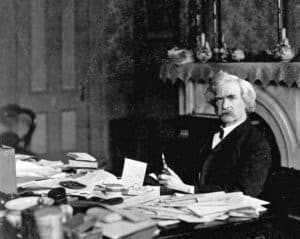
Mark Twain (1835-1910)
Mark Twain, aka Samuel Clemens, author of The Adventures of Tom Sawyer and Adventures of Huckleberry Finn, rose early Monday through Saturday to eat a hearty breakfast, then immediately retreated to his study. He remained in there writing until around 5 p.m., working straight through the day and even skipping lunch. Twain’s family was taught to never disturb him while he was writing or even come near his study so that he wouldn’t be distracted. If they absolutely needed him, the family was instructed to blow a horn from another part of the house, which would get his attention. It was Twain’s habit to keep four or five books in process all the time and to continually add new chapters to two or three each year to move the process along. “It takes seven years to complete a book by this method but still it is a good method: gives the public a rest.”
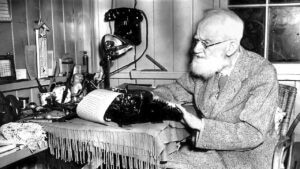
George Bernard Shaw (1856-1950)
Known for his role in revolutionizing the comedy-drama, English playwright George Bernard Show sought inspiration in the garden of his Edwardian villa, known as “Shaw Corner,” in a writing shed he had constructed on the property. While he had a traditional study, most of his writing happened in the shed, which was built on a turntable and designed to rotate so his writing desk, which faced the window looking across the lawns and gardens, always received the best light to work in. Shaw’s writing hut also included “an electric heater, a typewriter, a bunk for Napoleonic naps and a telephone to the house which could be used for emergencies such as lunch: surely everything a writer could need,” says his biographer, Michael Holroyd. His writing shed not only allowed Shaw to work in and be inspired by nature but to seek refuge from people. Shaw Corner and the writing shed have been preserved by The National Trust much as he left it.
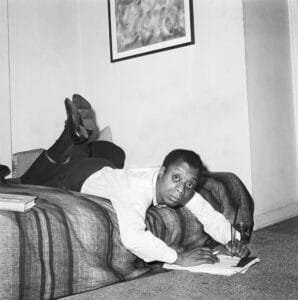
James Baldwin (1924-1987)
Novelist and playwright James Baldwin is known for many works including his essay collection Notes of a Native Son. He had unique writing habits because he often had a day job. He would begin his writing work at night once his kids were in bed. Even when he became established enough in his writing career to ditch the day job, he continued writing at night when he would be alone. “When you’re writing, you’re trying to find out something which you don’t know,” said Baldwin in a 1984 interview with The Paris Review. “The whole language of
writing for me is finding out what you don’t want to know, what you don’t want to find out. But something forces you to anyway.”
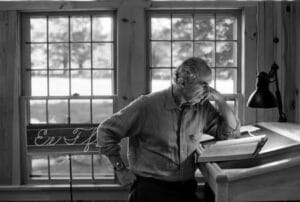
Philip Roth at his standing desk in his Connecticut retreat.
Philip Roth (1933-2018)
Before he retired in 2012 from writing, famed American Novelist Philip Roth, author of Goodbye, Columbus, Portnoy’s Complaint, and the Pulitzer Prize-winning American Pastoral, exclusively used standing desks, with one in his Upper West Side work studio and another at his house in the woods of Connecticut. He keeps his desks near windows but at right angles to the view, presumably to avoid distraction. Roth claims he would pace for about half a mile for every page he writes. With Roth’s astonishing body of work, that’s a lot of walking! In a 1984 interview with Hermione Lee, Roth shares, “I work all day, morning and afternoon, just about every day. If I sit there like that for two or three years, at the end I have a book. “Writing isn’t hard work …, it’s a nightmare.”





Related posts: